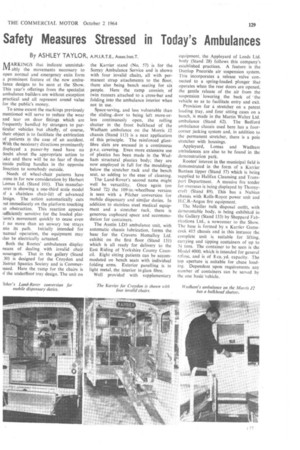Safety Measures Stressed in Today's Ambulances
Page 133

If you've noticed an error in this article please click here to report it so we can fix it.
By ASHLEY TAYLOR, A.M.I.R.T.E., Assoc.Inst.T.
VIARK1NGS that indicate unmistakIV-I ably the movements necessary to open normal and emergency exits form a prominent feature of the new ambulance designs to be seen at the Show. This year's offerings from the specialist ambulance builders are without exception practical and all represent sound value for the public's money.
To some extent the markings previously mentioned will serve to reduce the wear and tear on door fittings which are frequently handled by strangers to particular vehicles but chiefly, of course, their object is to facilitate the extrication of patients in the case of an accident. With the necessary directions prominently iisplayed a passer-by need have no loubt about the appropriate action to .ake and there will be no fear of those inside pulling handles in the opposite Erection to somebody outside.
Needs of wheel-chair patients have 2:0111C in for new consideration by Herbert Lomas Ltd. (Stand 101). This manufac.urer is showing a one-third scale model )f a chainless chair-lift of advanced lesign. The action automatically cuts )ut immediately on the platform touching in obstruction. This reaction appears iufficiently sensitive for the loaded plat:ores movement quickly to cease even f no more than an unwary toe strays nto its path. Initially intended for nanual operation, the equipment may Lis° be electrically actuated.
Both the Routes' ambulances display neans of dealing with invalid chair passengers. That in the gallery (Stand 30) is designed for the Croydon and iistrict Spastics Society and is Commerlased. Here the ramp for the chairs is if the underfloor tray design. The unit on the Karrier stand (No. 57) is for the Surrey Ambulance Service and is shown with four invalid chairs, all with permanent strap attachments to the floor, there also being bench seating for six people. Here the ramp consists, of twin runners attached to a cross-bar and folding into the ambulance interior when not in use.
Space-saving, and less vulnerable than the sliding-door to being left more-orless continuously open, he rolling shutter in the front bulkhead of the Wadham ambulance on the Morris J2 chassis (Stand 113) is a neat application of this principle. The reinforced glassfibre slats are encased in a continuous p.v.c. covering. Even more extensive use of plastics has been made in the Wadham structural plastics body; they are now employed in full for the mouldings below the stretcher rack and the bench seat, so adding to the ease of cleaning.
The Land-Rover's second name might well be versatility. Once again (on Stand 72) the 109-in.-wheelbase version is seen with a Pilcher conversion for mobile dispensary and simijar duties. In addition to stainless steel medical equipment and a stretcher rack, there is generous cupboard space and accommodation for containers.
The Austin LD5 ambulance unit, with automatic chassis lubrication, forms the base for the Cravens Homalloy Ltd. exhibit on the first floor (Stand 131) which is all ready for delivery to the East Riding of Yorkshire County Council. Eight sitting patients can be accommodated on bench seats with individual folding arms. Exterior panelling is in light metal, the interior in glass fibre.
Well provided with supplementary equipment, the Appleyard of Leeds Ltd_ body (Stand 28) follows this company's established practices. A feature is the Dunlop Pneuride air suspension system. This incorporates a release valve connected to a spring-loaded, plunger that operates when the rear doors are opened, the gentle release of the air from the suspension lowering the back of ' the vehicle so as to facilitate entry and exit.
Provision for a stretcher on a patent loading tray, and four sitting cases on a bench, is made in the Martin Walter Ltd. ambulance (Stand 62). The Bedford ambulance chassis used here has a fourcorner jacking system and, in addition to the permanent stretcher, there is a pole stretcher with housings.
Appleyard, Lomas and Wadham ambulances are also to be found in the demonstration park.
Rootes' interest in the municipal field is demonstrated in the form of a Karrier Bantam tipper (Stand 57) which is being supplied to Halifax Cleansing and Transport Department. A massive fire tender for overseas is being displayed by Thornycroft (Stand 89). This has a Nubian chassis with Rolls-Royce power unit and H.C.B.-Angus fire equipment.
The Meiller hulk disposal outfit, with demountable body, is being exhibited in the Gallery (Stand 133) by Sheppard Fabrications Ltd., a newcomer to the Show. The base is formed by a Karrier Gamecock 415 chassis and in this instance the complete unit is suitable for lifting, carrying and tipping containers of up to 3i tons. The container to be seen is the Model 4000, which is intended for general refuse, and is of 8 cu. yd. capacity. The top aperture is suitable for chute loading. Dependent upon requirements any number of containers can be served by the one basic Vehicle.






























































































































































































































